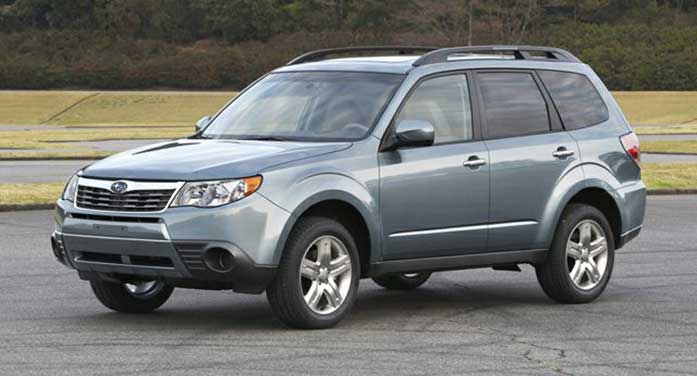 In 2012, Subaru’s Forester was going into its 15th year. Based on the Impreza platform, and manufactured in Japan, it also received a bit of a redesign the year before, getting increased back seat elbow room and all-new rear suspension.
In 2012, Subaru’s Forester was going into its 15th year. Based on the Impreza platform, and manufactured in Japan, it also received a bit of a redesign the year before, getting increased back seat elbow room and all-new rear suspension.
Where the previous version featured strut suspension in back, this, the third-generation model, came with a double-wishbone arrangement. Among other things, it helped improve interior dimensions and gave it a longer wheelbase and, consequently, a more civilized ride.
As is the case with all Subaru products, this iteration of the Forester has a full-time all-wheel-drive system, offered with either a turbocharged or normally aspirated engine and your choice of a five-speed manual or four-speed automatic transmission. A traction control system is standard on all models, as is a hill-holder feature that also works in reverse, four-wheel anti-lock disc brakes, and a vehicle dynamics control system.
The 2.5-litre horizontally opposed four-cylinder engine propelling the 2012 Forester develops 170 horsepower in normally-aspirated form, and 224 turbocharged. The non-turbo engines have a timing chain instead of a belt, which is noteworthy.
Equipment level is comparatively high; heated seats, power outside heated mirrors, air conditioning, power windows, tilt/telescoping steering, and 16-inch wheels and tires all come standard, and it has six trim levels. Extras include leather interior, aluminum alloy sport pedals, high intensity “hawkeye” headlights, roof rails, and a huge “panoramic” power sunroof. This last item was the biggest sunroof in this category. A premium sound system came with the Limited and turbocharged versions, but a navigation system was not offered in Canada.
Transport Canada has one safety recall for this iteration of the Forester, and it’s directed at turbocharged models. Apparently, the weld connecting the oil supply pipe to the turbocharger may crack, and if it does, oil may spill out and possibly cause an engine fire. This contretemps also extended to the Impreza.

As is the case with all Subaru products, this iteration of the Forester has a full-time all-wheel-drive system, offered with either a turbocharged or normally aspirated engine
To this, we can add a widespread problem with Thule aftermarket roof storage units. Apparently, on some models, the bolts securing the unit to the vehicle could break and cause all kinds of havoc. This recall applied to an impressive range of vehicles, and Thule provided new bolts to replace the old, gratis.
| MORE AUTO REVIEWS |
Ten technical service bulletins are on file with the U.S.-based National Highway Traffic Safety Administration (NHTSA), ranging from software issues to problems refilling the gas tank in cold weather, to a leaky front body panel, to problems with the catalytic converter, to persistent oil leaks.
Nothing but smiles and love from Consumer Reports, though. This organization put Subaru products on its “best cars” list in 2012, and the Forester received a “recommended” designation. The Forester also received top marks in every single category and got a top used car prediction rating.
“Best vehicle I ever had,” claimed one owner; “a nice box that goes down the road well,” said another; and “more like a sports car than an SUV,” added another.
That said, complaints about mediocre fuel economy and unsupportive seats seem to be common. And, like all Subarus, if you let your coolant and/or oil level go down, you’re asking for trouble. If these engines overheat, you’re done for.
From a base price of just under $27,000 in 2012, the Forester seems to be going from the low to mid-teens these days. The turbocharged models are fetching slightly more than their naturally-aspirated counterparts, but that may be because they have a higher level of standard equipment.
2012 Subaru Forester
Original base price: $26,595
Engine: 2.5-litre horizontally-opposed four-cylinder, normally aspirated and turbocharged
Horsepower: 170 or 224 hp
Torque: 170 or 226 foot pounds
Transmission: Four-speed automatic or five-speed manual
Fuel economy (litres/100 km): 10.5 city and 7.6 highway, for the non-turbo with manual transmission, with regular gas
Alternatives: Honda CR-V, Toyota RAV4, Chevrolet Equinox, Nissan Rogue, Mazda Tribute, Mazda CX-7, Ford Escape, Hyundai Santa Fe
Ted Laturnus has been an automotive journalist since 1976. He was named Canadian Automobile Journalist of the Year twice and is past president of the Automobile Journalists Association of Canada (AJAC). For interview requests, click here.
The opinions expressed by our columnists and contributors are theirs alone and do not inherently or expressly reflect the views of our publication.
© Troy Media
Troy Media is an editorial content provider to media outlets and its own hosted community news outlets across Canada.


